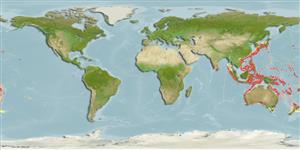Actinopterígios (peces con aletas radiadas) >
Ateleopodiformes (Jellynose fishes) >
Ateleopodidae (Jellynose fishes)
Etymology: Ateleopus: Greek, ateles = imperfect + Greek, pous = foot (Ref. 45335). More on author: Bleeker.
Medioambiente / Clima / Gama
Ecología
; marino batidemersal; rango de profundidad 140 - 600 m (Ref. 44036). Deep-water, preferred ?
Western Pacific: southern Japan. More recent works report of its occurrence in Taiwan (Ref. 5193), Malaysia (Ref. 5756) and the Chesterfield Islands (Ref. 11897).
Tamaño / Peso / Age
Maturity: Lm ? range ? - ? cm
Max length : 95.0 cm SL macho / no sexado; (Ref. 559); common length : 35.0 cm NG macho / no sexado; (Ref. 27550)
Espinas dorsales (total): 0; Radios blandos dorsales (total): 8-10; Espinas anales 0. Longest ray of pelvic fin thin, long reaching to or near tip of pectoral fin. Lip of upper jaw thin. Upper jaw with a short band of villiform teeth; lower jaw, palatine, pre vomer and tongue toothless. Body purplish-brown, semi-transparent. Attain 95 cm SL.
Feeds on prawns (Ref. 27550).
Life cycle and mating behavior
Madurez | Reproducción | Puesta | Huevos | Fecundidad | Larva
Masuda, H., K. Amaoka, C. Araga, T. Uyeno and T. Yoshino, 1984. The fishes of the Japanese Archipelago. Vol. 1. Tokai University Press, Tokyo, Japan. 437 p. (text). (Ref. 559)
IUCN Red List Status (Ref. 115185)
CITES (Ref. 94142)
Not Evaluated
Threat to humans
Harmless
Human uses
Pesquerías: sin interés
Más información
ReferenciasAcuiculturaPerfil de acuiculturaRazasGenéticaFrecuencias de alelosheritabilidadEnfermedadesProcesamientoMass conversion
Herramientas
Special reports
Download XML
Fuentes de Internet
